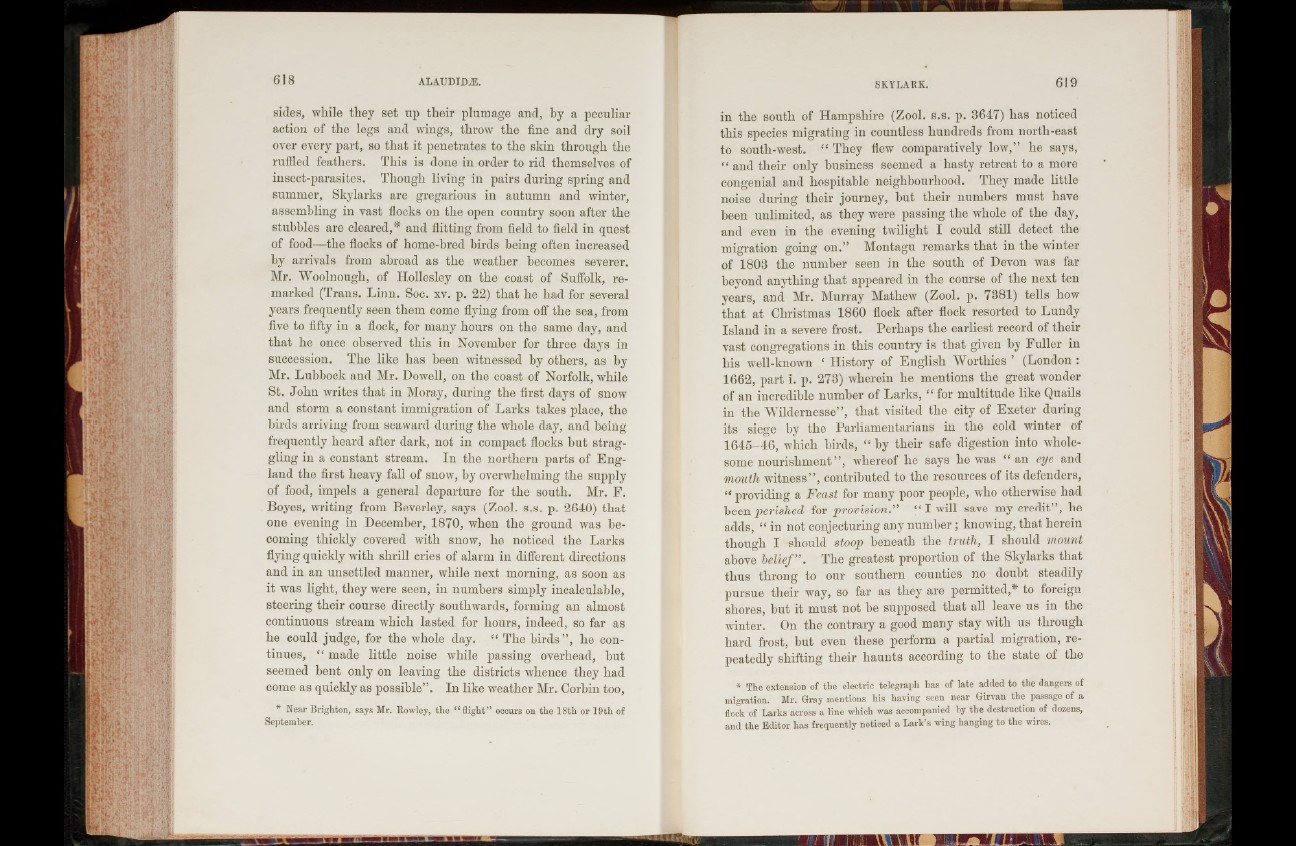
sides, while they set up their plumage and, by a peculiar
action of the legs and wings, throw the fine and dry soil
over every part, so that it penetrates to the skin through the
ruffled feathers. This is done in order to rid themselves of
insect-parasites. Though living in pairs during spring and
summer, Skylarks are gregarious in autumn and winter,
assembling in vast flocks on the open country soon after the
stubbles are cleared,* and flitting from field to field in quest
of food—the flocks of home-bred birds being often increased
by arrivals from abroad as the weather becomes severer.
Mr. Woolnough, of Hollesley on the coast of Suffolk, remarked
(Trans. Linn. Soc. xv. p. 22) that he had for several
years frequently seen them come flying from off the sea, from
five to fifty in a flock, for many hours on the same day, and
that he once observed this in November for three days in
succession. The like has been witnessed by others, as by
Mr. Lubbock and Mr. Dowell, on the coast of Norfolk, while
St. John writes that in Moray, during the first days of snow
and storm a constant immigration of Larks takes place, the
birds arriving from seaward during the whole day, and being
frequently heard after dark, not in compact flocks hut straggling
in a constant stream. In the northern parts of England
the first heavy fall of snow, by overwhelming the supply
of food, impels a general departure for the south. Mr. E.
Boyes, writing from Beverley, says (Zool. s.s. p. 2640) that
one evening in December, 1870, when the ground was becoming
thickly covered with snow, he noticed the Larks
flying quickly with shrill cries of alarm in different directions
and in an unsettled manner, while next morning, as soon as
it was light, they were seen, in numbers simply incalculable,
steering their course directly southwards, forming an almost
continuous stream which lasted for hours, indeed, so far as
he could judge, for the whole day. “ The birds”, he continues,
“ made little noise while passing overhead, hut
seemed bent only on leaving the districts whence they had
come as quickly as possible” . In like weather Mr, Corbin too,
* Near Brighton, says Mr. Rowley, the “ flight” occurs on the 18th or 19th of
September.
in the south of Hampshire (Zool. s.s. p. 3647) has noticed
this species migrating in countless hundreds from north-east
to south-west. “ They flew comparatively low,” he says,
“ and their only business seemed a hasty retreat to a more
congenial and hospitable neighbourhood. They made little
noise during their journey, but their numbers must have
been unlimited, as they were passing the whole of the day,
and even in the evening twilight I could still detect the
migration going on.” Montagu remarks that in the winter
of 1803 the number seen in the south of Devon was far
beyond anything that appeared in the course of the next ten
years, and Mr. Murray Mathew (Zool. p. 7381) tells how
that at Christmas 1860 flock after flock resorted to Lundy
Island in a severe frost. Perhaps the earliest record of their
vast congregations in this country is that given by Fuller in
his well-known ‘ History of English Worthies ’ (London :
1662, part i. p. 273) wherein he mentions the great wonder
of an incredible number of Larks, “ for multitude like Quails
in the Wildernesse” , that visited the city of Exeter during
its siege by the Parliamentarians in the cold winter of
1645-46, which birds, “ by their safe digestion into wholesome
nourishment” , whereof he says he was “ an eye and
moutli witness” , contributed to the resources of its defenders,
“ providing a Feast for many poor people, who otherwise had
been perished for provision.” “ I will save my credit” , he
adds, “ in not conjecturing any number; knowing, that herein
though I should stoop beneath the truth, I should mount
above belief”. The greatest proportion of the Skylarks that
thus throng to our southern counties no doubt steadily
pursue their way, so far as they are permitted,* to foreign
shores, but it must not be supposed that all leave us in the
winter. On the contrary a good many stay with us through
hard frost, but even these perform a partial migration, repeatedly
shifting their haunts according to the state of the
* The extension of the electric telegraph lias of late added to the dangers of
migration. Mr. Gray mentions his having seen near Girvan the passage of a
flock of Larks across a line which was accompanied by the destruction of dozens,
and the Editor has frequently noticed a Lark’s wing hanging to the wires.